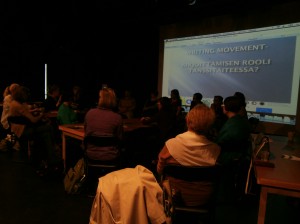Kuopio Festival joins the Writing Movement
The third Finnish Writing Movement seminar event took place in Kuopio in collaboration with the Regional Dance Center of Eastern Finland, and Finland’s biggest dance festival Kuopio Tanssii ja Soi. The event consisted of a panel discussion and a short writing workshop, which was led by the journalist Raisa Rauhamaa. The theme of the day was a broad question about the situation of dance writing in the dance field, and beyond. The aim of the Finnish Writing Movement seminars is to activate discussion among the dance professionals and writers also outside the capital area and involve more people in issues of dance writing.
Writing is a personal act
The panel discussion was opened by two short introductory talks by the local dance artist and curator Johanna Tuukkanen, and the journalist Hannele Jyrkkä who is a freelance dance critic and an author of several dance related books. Tuukkanen has also written for newspapers. Broadening the understanding about dance as an art form has been her motivation for writing. She would personally like to read more about artistic processes and encouraged artists to write more themselves. She emphasized that writing is always a subjective matter and that the work of critic also should be seen positively for opening the critical discourse in the field.
Hannele Jyrkkä also talked about her own motivation for writing about dance. For her, writing equals thinking, and she likes the fact that she captures the art of a moment in a more permanent form. Reworking the stereotypical approaches about dance is an issue that’s also dear to her heart. She thinks that the act of trying to understand the piece always has to be visible in the text however critical you still might be. The critic has to have the courage to “be bare”. She was apologetic towards the space and time you usually have when writing to the newspapers always making it so difficult to connect the piece into wider artistic and social context. Allowing more time to think and to process was a big reason for wanting to write books.
Dialogue with the reader
Minna Tawast, the editor in chief of Dance and Theatre magazine, Piia Ahonen, the independent dance critic and communication officer of Dance Info Finland, and Isto Turpeinen, the dance scholar accompanied Johanna Tuukkanen and Hannele Jyrkkä in the panel moderated by the above mentioned Raisa Rauhamaa.
Tawast talked about the importance of the social context: As a journalist she writes for the readers, not for the dance enthusiasts, and that is why the text always has to be relevant in the present moment in the Finnish society. To share the knowledge about dance is important too but the experiences have to be understandable also for a reader who is not “inside the art circle”.
Ahonen told the audience that she writes because of a selfish motivator: she doesn’t know any better thing than to share the experience of a dance piece and trying to put it into words. For her, the most important thing is to appreciate the art and she likes to emphasize the interpretation.
Turpeinen pointed out that the critique contains the idea of a dialogue which is always important. Writing is also political and he thinks that the field always benefits for it. The most intense debate among the panelists raised the question if the critique as a form is needed anymore. As a result they all agreed that it is important to be critical about everything, also about dance, especially because it is most often financed by the public sector. The critique opens the art for a wider audience as well as keeps it transparent and accessible. As Turpeinen underlined, it also opens up discussions, however private they could end up to be, around the coffee tables and in pubs.
Writing and vulnerability
In the afternoon, Raisa Rauhamaa asked participants to write a short text about the piece they saw last night. You could choose whether to write about the first and strongest impressions that popped out in your head after the performance, or try to describe the movement language and the way it shows how the piece speaks, why it speaks as it speaks.
The participants read the texts aloud and everybody could give a feedback. Rauhamaa pointed out how every word has a meaning, and nothing is “free of charge”. She also reminded everybody that being unclear is not a way to show intelligence, being simple is quite often the better solution. She also thinks that every writer, to strengthen the underground discourse and weak status of dance in society, should always avoid taking on a defensive attitude.
Reading the texts aloud was a vulnerable thing to do and reminded everybody of the huge responsibility and personal input that is included in writing. The whole day showed how you always have to be open and sensitive to your own work and to new perspectives, no matter how experienced you are in writing, or in dance.
Veera Lamberg is the leading moderator and editor of Liikekieli.com and coordinator of Finnish Writing Movement.
